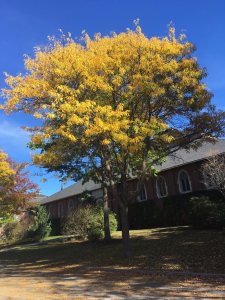Honey Locust
Gleditsia triacanthos | Family: Fabaceae
Submission: Nathaniel Reed ‘20
Natural History:
 A tolerant, thorn-clad tree native to the central United States, honey locust (Gleditsia triacanthos) is a somewhat fast-growing tree often found on limestone soils or moist bottomlands. It ranges from Nebraska in the west to Pennsylvania in the east and from Louisiana in the south to Minnesota in the north. While the honey locust range covers many states, they are concentrated mostly in Southern Illinois and Indiana, in stream valleys and wetlands. Proven to be very hardy and tolerant of salinity and drought, this tree has been widely planted to combat soil erosion and to form windbreaks. Honey locust wood is very dense, shock resistant, and commonly used in the timber industry. The durable wood is often used for fence posts, railroad ties, pallets, tool handles, and fuel, given that it can be easily split and is rot-resistant. Because it can have a very nice, high-luster finish it is also used for making furniture. One of the first documented uses of honey locust timber was by the Cherokee in Tennessee who used it to make bows.
A tolerant, thorn-clad tree native to the central United States, honey locust (Gleditsia triacanthos) is a somewhat fast-growing tree often found on limestone soils or moist bottomlands. It ranges from Nebraska in the west to Pennsylvania in the east and from Louisiana in the south to Minnesota in the north. While the honey locust range covers many states, they are concentrated mostly in Southern Illinois and Indiana, in stream valleys and wetlands. Proven to be very hardy and tolerant of salinity and drought, this tree has been widely planted to combat soil erosion and to form windbreaks. Honey locust wood is very dense, shock resistant, and commonly used in the timber industry. The durable wood is often used for fence posts, railroad ties, pallets, tool handles, and fuel, given that it can be easily split and is rot-resistant. Because it can have a very nice, high-luster finish it is also used for making furniture. One of the first documented uses of honey locust timber was by the Cherokee in Tennessee who used it to make bows.
Native Americans have also used the crushed seed pods, for which the tree was named, as a sweetening agent and as a minor food source. The pods are especially rich in carbohydrates and proteins, possess a very sweet flavor, and are readily available in certain regions, making them agriculturally important historicaly for many people. Another agricultural implementation of honey locust seed pods is in the feeding of livestock, such as hogs, goats, sheep, and cattle. During the Civil War, the Cenfederate Army used honey locust thorns as pins to hold their uniforms together.Various parts of the plant have even been used medicinally. Extracts of the honey locust have been found useful in treating some modern ailments, such as rheumatoid arthritis as well as some cancers. Humans likely began exploiting the plant for different uses after observing a variety of wildlife. The bean pods are commonly eaten by many herbivores and scavengers, such as squirrels, rabbits, white-tailed deer, opossums, and raccoons. Sheep, cattle, and deer feed on the tender shoots in spring and on the bark of young trees during winter, while the small, greenish-yellow flowers attract many insects, especially bees.
Honey locusts are a common ornamental, as their small leaves and somewhat open canopy allow grasses and other plants to grow beneath them. Their hardy nature allows them to be planted around parking lots, sidewalks, and in areas lacking other vegetation. Certain thorn-less and fruitless varieties have been used ornamentally in landscaping, as they are more forgiving for landscapers and homeowners.
Identification:
Leaves – Deciduous, alternate, generally bi-pinnately compound (to 32”); leaflets ovate, entire
Twigs/Buds – Relatively stout, with 3-branched thorns 2”-7” long (ornamental
varieties thornless), buds minute, superposed
Fruit – Red-brown to purple-brown, usually twisted legume, 7”-15” long
Bark – Becoming brown to black, lenticulate, with plates or superficially scaly ridges
References:
Arbor Day Foundation. (n.d.). Thornless Honeylocust: Gleditsia triacanthos form inermis. Retrieved April 26, 2016, from https://www.arborday.org/trees/treeguide/TreeDetail.cfm?itemID=852
Brockman, C.F. 1986. Trees of North America: A Guide to Field Identification. Revised Edition. Western Pub. Co., Inc. 280pp.
Burns, R. M., & Honkala, B. H. (1990). Silvics of North America (Vol. 2, pp. 714-725). Washington: U.S. Dept. of Agriculture, Forest Service.
Elias, T.S. 1980. The Complete Trees of North America Field Guide and Natural History. Van Nostrand Reinhold Co., N.Y. 948pp.
Harlow, W.M., Harrar, E.S., Hardin, J.W. and White, F.M. 1991. Textbook of Dendrology. McGraw-Hill Inc., N.Y. 501pp.
Kim, K., Adams, N., & Friedman, H. (n.d.). Yale Nature Walk: Honey Locust. Retrieved October 25, 2017, from http://naturewalk.yale.edu/trees/fabaceae/gleditsia triacanthos/honey-locust-18
Petrides, G.A. 1972. A Field Guide to Trees and Shrubs. 2nd edition. Houghton Mifflin Co., Boston. 428pp.
Preston, R.J., Jr. 1989. North American Trees. 4th edition. Iowa State Univ. Press. Ames. 407pp.
Seiler, J., Jensen, E., Niemiera, A., & Peterson, J. (2015). Gleditsia triacanthos Fact Sheet. Retrieved April 27, 2016, from http://dendro.cnre.vt.edu/dendrology/syllabus/factsheet.cfm?ID=30.
Shadow, R. A. (n.d.). Honey Locust Gleditisia triacanthos L. Plant Fact Sheet [PDF].
Nacogdoches, TX: USDA/NRCS East Texas Plant Materials Center. Retrieved April 27, 2016, from http://plants.usda.gov/factsheet/pdf/fs_gltr.pdf
Shane, J. 2004. Dendrology Handbook, University of Vermont, Unpublished.
What Tree Is It?, edited by Jim Kingery, Ohio Public Library Information Network, 1997. Accessed 25 Oct. 2017.